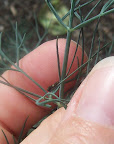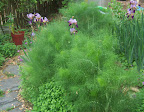Learning about the butterfly life cycle with local butterflies
By Peggy Ashbrook
Posted on 2010-05-07
This year I have challenged myself to use only local animals in the classroom, for budget and ecological reasons.
Luckily for me and my students, Cabbage White and Black Swallowtail butterflies go through their life cycle to adulthood in our area before the end of the school year and can easily be found on collard and fennel plants which wintered over (were planted in the fall and survive through the winter). I’ve also found the Cabbage White butterfly eggs on collard seedlings which I had washed thoroughly and set out in the yard.
Hoping to find a shortcut, I set out collard leaves from the grocery in a jar of water, but even though I had trimmed the stem ends, the leaves drooped from lack of water by the end of the day—not a very promising site to lay eggs! With two stands of five fennel plants each, and 3 packages of collard seedlings, I’ve been able to supply 15 classrooms with caterpillars and eggs.
Take a look…
She was repeatedly coming to the plants, landing for just a short time, then flying to another place on the fennel—I just wasn’t quick enough with the camera.
There were also aphids and another animal that is rounder with a tough exoskeleton that I haven’t been able to identify on the collard seedlings. These I washed off the leaves to leave more for the caterpillar. If I were teaching older children I would leave all the animals on the leaves and have the students research to identify them. I’m curious if the aphids, unknown round insect and the caterpillars happily co-exist or if they compete.
I brought some Cabbage white butterfly caterpillars into the house because it was due to storm the next morning and I wanted to take some to school. The next afternoon I noticed a pupa in chrysalis form on the hallway wall, almost two meters from the collard leaves. What a journey the caterpillar had made to its pupating place!
The children have been very excited to see, and draw butterfly eggs, and the Very Tiny Caterpillars. Many of them tell me (with wide eyes) that the caterpillar will change into a butterfly, something they have learned though reading or a television program. Now I hope that they will learn it through observations. Usually, only a few children remain interested in these relatively slow-moving animals except to comment on the poop. That observation is a good time to talk about what is alive and what is not, and how do we know, to learn what the children are thinking.
Because children do not watch the caterpillars continuously, they may not understand that the chrysalis is not a new animal but just a new form of the caterpillar that they had already seen. Even with prior experience of observing, handling, and counting Tenebrio beetles and larva (“mealworms”) which also form pupa and undergo complete metamorphosis, the children do not immediately accept this. When the butterfly emerges from its chrysalis, the children will be interested again. Butterflies can be fed with a sugar water solution for a day or two before being released. Nice to have a place to “borrow” butterfly eggs and babies; nice for the children to see them return to that place, the stand of fennel plants in the garden.
See my February 17 and May 6, 2009, posts for more information about keeping caterpillars in the classroom.
What are the challenges your classroom has in learning about animals that change as they grow?
Peggy
Disclaimer: The views expressed in this blog post are those of the author(s) and do not necessarily reflect the official position of the National Science Teaching Association (NSTA).






